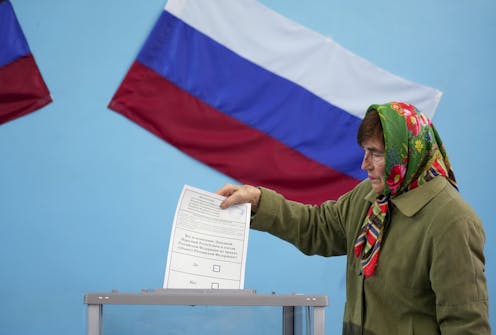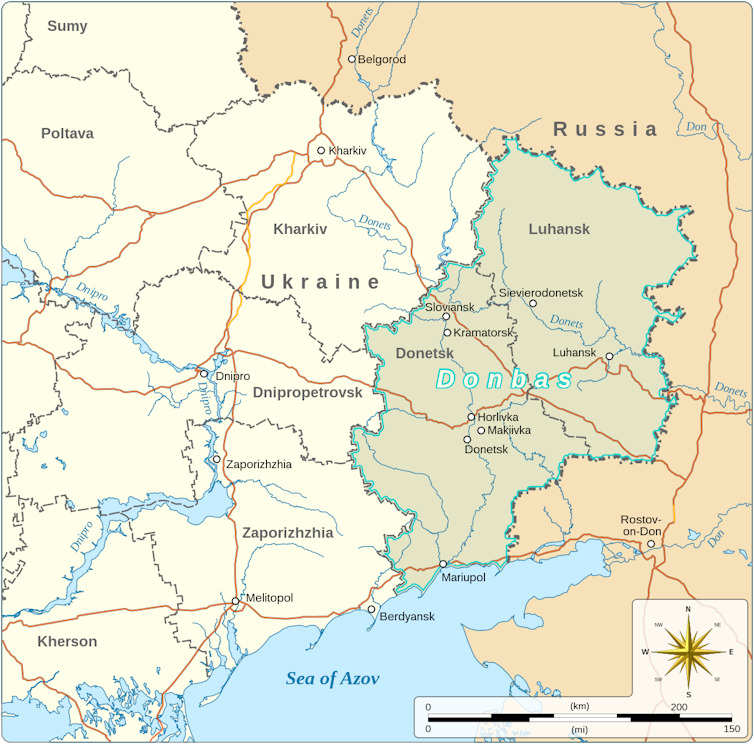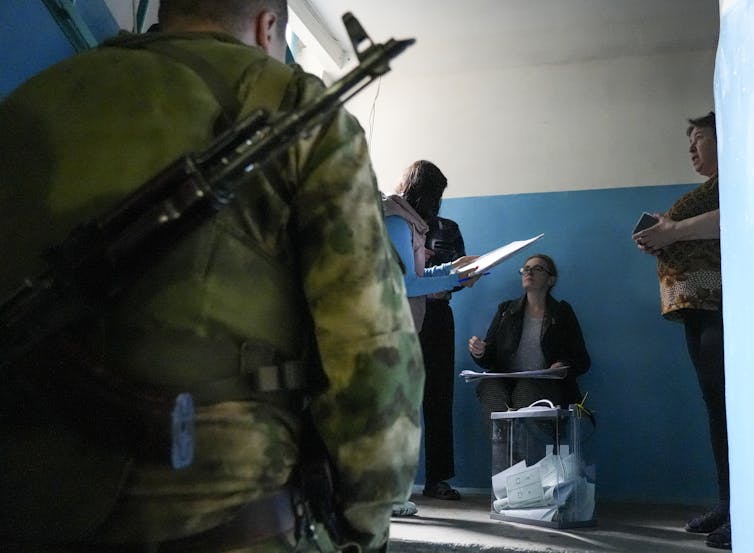Russia plans to annex parts of Eastern Ukraine – an Eastern European expert explains 3 key things to
While some parts of eastern Ukraine have been under partial Russian control since 2014, other sections continue to fight back. Most residents overall have said they don’t want to be part of Russia.

Russia is set to formally annex four occupied territories in eastern Ukraine, claiming the region as its own more than six months after it first invaded its neighboring country.
Russia announced on Sept. 27, 2022, that more than 85% of people in the self-proclaimed Luhansk People’s Republic and Donetsk People’s Republic, as well as parts of two other occupied regions in Ukraine – Kherson and Zaporizhshia – voted to become part of Russia.
But the United Nations, the United States and Ukrainian officials have all decried the process as a “sham” and illegal.
The Group of Seven, an international political coalition with Canada, France, Germany, Italy, Japan, the United Kingdom and the U.S. as members, also condemned Russia’s referendums as “illegitimate.” The G7 leaders have promised to impose sanctions on Russia if it proceeds with the annexation.
There are reports that Russian and Chechen soldiers have pressured people at their homes and at voting sites to align with Russia.
As a researcher of Eastern Europe, I think it’s important to understand that people in these four regions are not a single political bloc, even though most of the people in these territories do not want to join Russia.

The four Ukrainian regions have distinct relationships with Russia
Russian forces first occupied parts of Kherson, a port city, and Zaporizhzhia, a city that’s home to the largest nuclear facility in Europe, earlier in 2022.
But even before Russia’s full invasion of Ukraine in February 2022, it also controlled parts of the Luhansk and Donetsk regions. The Kremlin has supported and armed two puppet separatist governments in this region, known as Donbas, since 2014.
In May 2014, breakaway Ukrainian politicians proclaimed that Donetsk and Luhansk were not part of Ukraine, but actually were independent “republics.”

The Kremlin did not officially recognize these newly proclaimed republics until February 2022, when Russian President Vladimir Putin launched its invasion of Ukraine days later.
As Russia turned to conscript fighters in these breakaway regions to fill front lines, Zaporizhzhia and Kherson have been fighting against Russia since the start of the war.
In March 2022, Ukrainian President Volodymyr Zelensky awarded the honorary title of “Hero City” to Kherson for its fierce defense against Russian forces during the early days of the war.
Russia still does not fully control any of the four regions. Zelensky vowed in August 2022 to not hold any peace talks if the Kremlin proceeded with the referendums in the occupied areas.

Demographics in eastern Ukraine have shifted during the war
Most Ukrainians who live in the Donbas region speak Russian. But before the full-scale war in 2022, many of these people still preferred to identify as having mixed Ukrainian and Russian identities – or, otherwise, as a person from the Donbas or a Ukrainian citizen.
The Donbas region was home to about 6.5 million people before the 2022 invasion, out of a total 43 million in Ukraine.
The region was once known for its industrial output and coal mines, some of which Russia has seized control of during the war.
Today, all four of the occupied regions are active war zones that many residents have fled. According to the United Nations Refugee Agency, over 11 million Ukrainians have left the country since February 2022.
There are also up to 7 million Ukrainians who have been uprooted from their homes but still live in Ukraine, making them internally displaced. More than 60% of the internally displaced Ukrainians are from the eastern regions.
As a result, the Russian referendum votes were conducted without accounting for the opinion of half – or even the majority – of the population in these territories.

Most Ukrainians in the occupied territories don’t want to be part of Russia
In 2014, when Luhansk and Donetsk first proclaimed their independence, the majority of the people there said they preferred to be part of their own republic, rather than becoming a part of Russia. Approximately 52% of people in these regions at the time said they were against joining Russia, while 28% in Donetsk and 30% in Luhansk supported it, according to the Kyiv International Institute of Sociology, a private research group in Ukraine that conducts sociological and marketing research.
At the same time, both Kherson and Zaporizhzhia were overwhelmingly against joining Russia. Approximately 85% of people in Kherson and 82% in Zaporizhzhia said they wanted to remain separate, according to the Kyiv International Institute of Sociology.
After eight years of fighting, which has led to destruction of houses and infrastructure, as well as thousands of civilian deaths in eastern Ukraine, the number of Russian sympathizers in the Donbas decreased.
The Kyiv International Institute of Sociology reported that in late 2021 and early 2022, less than 22% of people in the Donbas region and less than 12% in Kherson and Zaporizhzhia wanted to become part of Russia.
Over 52% of Donbas residents, meanwhile, said in separate surveys conducted by American polling experts in early 2022 that they were apathetic about where to live, whether in Russia or in Ukraine. What most people cared about was their financial stability and family’s overall well-being.
Since the 2022 invasion, 92% of polled residents in the Donbas said that there should be no territorial concessions for the earliest possible end of the war, according to the Kyiv International Institute of Sociology.
These figures contradict Putin’s justification to launch the so-called “special military operation” to defend a Russian-speaking population that Ukraine is allegedly persecuting.
Tatsiana Kulakevich does not work for, consult, own shares in or receive funding from any company or organisation that would benefit from this article, and has disclosed no relevant affiliations beyond their academic appointment.
Read These Next
How the ‘slayer rule’ might play a role in determining who will inherit wealth from Rob Reiner and h
These rules have a long history in the United States. They played a role in the notorious murders by…
From truce in the trenches to cocktails at the consulate: How Christmas diplomacy seeks to exploit s
World leaders like to talk up peace at Christmastime. But alongside the tales of seasonal breaks in…
As DOJ begins to release Epstein files, his many victims deserve more attention than the powerful me
Powerful men connected to Jeffrey Epstein are named, dissected and speculated about. The survivors,…






